Multi-Centennial Disturbance History and Terrestrial Carbon Transfers in a Coastal Forest Watershed Before and During Reservoir Development
Abstract
1. Introduction
Study Area
2. Methods and Data
3. Results
3.1. Historic Development Period
3.2. Watershed Evolution 1770–2014
4. Discussion
4.1. Development Period 1911–2014
Modelled Terrestrial DOC Exports and Sediment C Accumulations 1911–2012
4.2. Pre-Development Period Before 1910
4.3. Organic C Sources and Accumulation Rates in Lake Sediments
5. Conclusions
Author Contributions
Funding
Data Availability Statement
Acknowledgments
Conflicts of Interest
Appendix A
Appendix A.1. Carbon and Nitrogen Totals and Isotope Ratios: Detailed Methods
Appendix A.2. Pyrolysis-Gas Chromatography-Mass Spectrometry (pyGC-MS): Detailed Methods
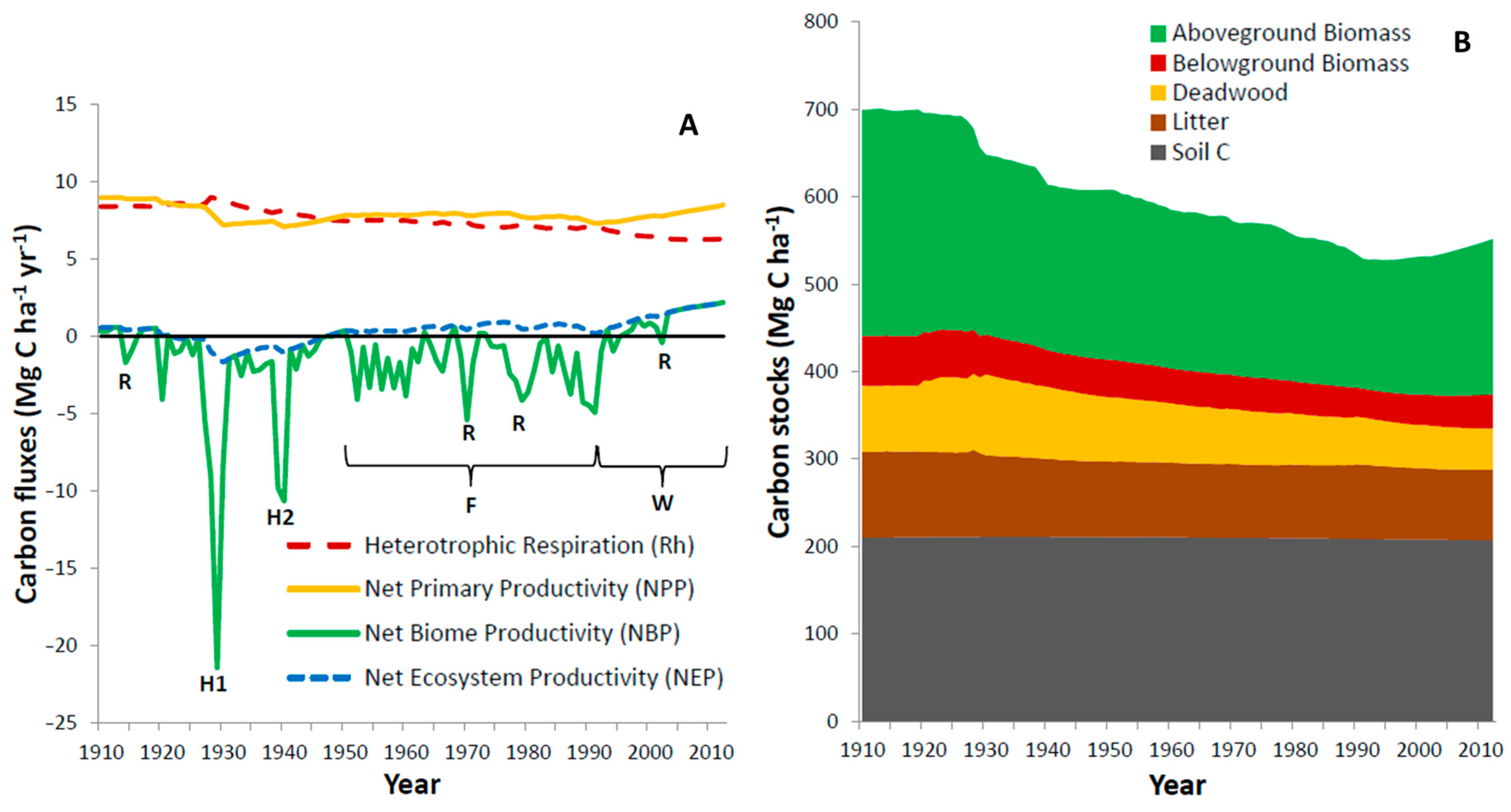
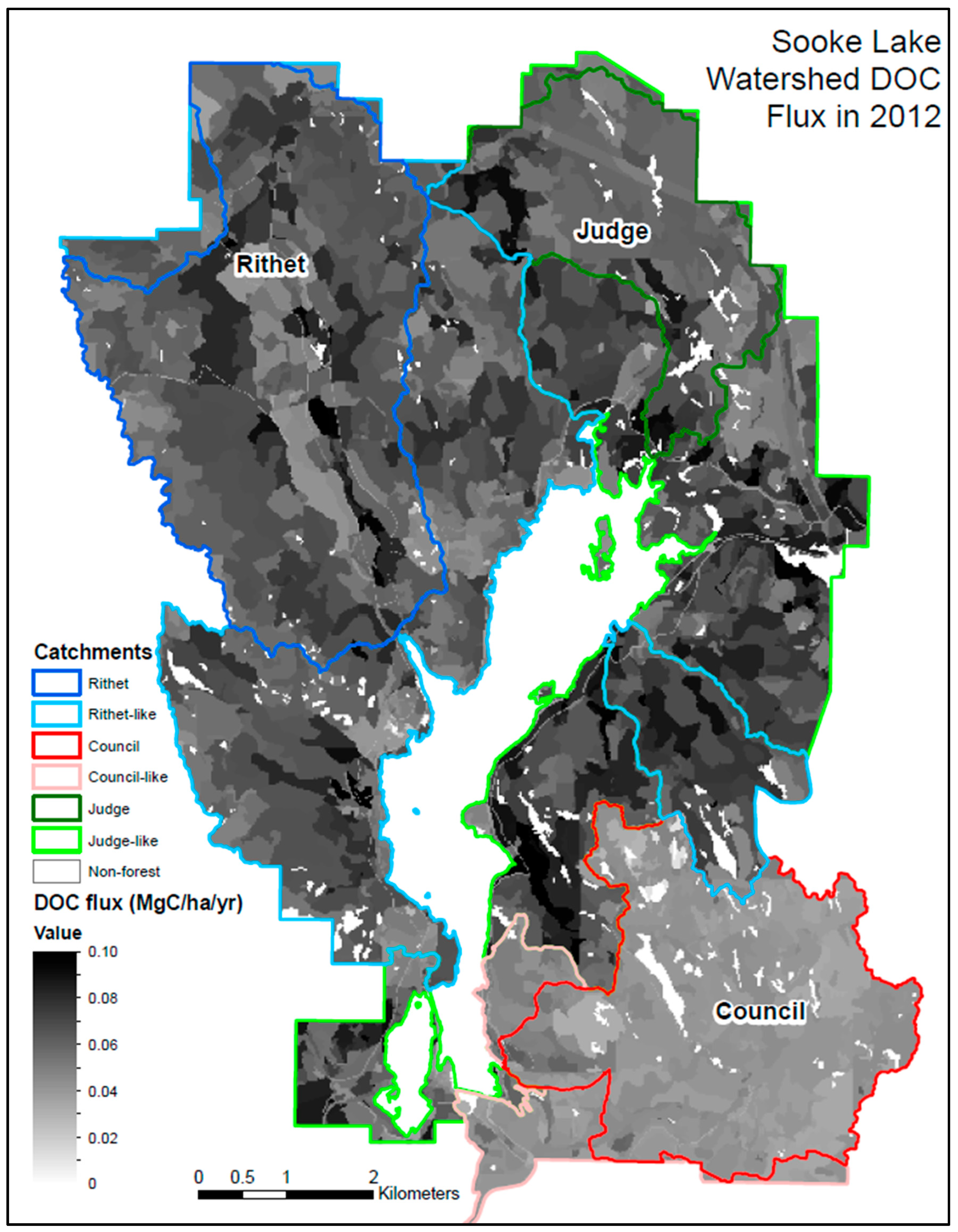
References
- Tans, P.; Keeling, R. Trends in Atmospheric Carbon Dioxide. ESRL Global Monitoring Division—Global Greenhouse Gas Reference Network. 2015. Available online: http://www.esrl.noaa.gov/gmd/ccgg/trends/index.html (accessed on 7 September 2015).
- Solomon, S.; Plattner, G.K.; Knutti, R.; Friedlingstein, P. Irreversible climate change due to carbon dioxide emissions. Proc. Natl. Acad. Sci. USA 2009, 106, 1704–1709. [Google Scholar] [CrossRef]
- Cao, L.; Caldeira, K.; Jain, A.K. Effects of carbon dioxide and climate change on ocean acidification and carbonate mineral saturation. Geophys. Res. Lett. 2007, 34, 2006GL028605. [Google Scholar] [CrossRef]
- Luo, Y.; Keenan, T.F.; Smith, M. Predictability of the terrestrial carbon cycle. Glob. Change Biol. 2014, 21, 1737–1751. [Google Scholar] [CrossRef]
- Zhao, J.; Liu, D.; Zhu, Y.; Peng, H.; Xie, H. A review of forest carbon cycle models on spatiotemporal scales. J. Clean. Prod. 2022, 339, 130692. [Google Scholar] [CrossRef]
- IPCC. Good Practice Guidance for Land Use, Land-Use Change and Forestry; Penman, J., Gytarsky, M., Hiraishi, T., Krug, T., Kruger, D., Pipatti, R., Buendia, L., Miwa, K., Ngara, T., Tanabe, K., et al., Eds.; IGES: Kanagawa, Japan, 2003; Available online: https://www.ipcc-nggip.iges.or.jp/public/gpglulucf/gpglulucf_contents.html (accessed on 25 August 2025).
- IPCC. Climate Change 2014: Synthesis Report. Contribution of Working Groups I, II and III to the Fifth Assessment Report of the Intergovernmental Panel on Climate Change; Core Writing Team, Pachauri, R.K., Meyer, L.A., Eds.; IPCC: Geneva, Switzerland, 2014; Volume 151, pp. 2–54. [Google Scholar]
- Goodale, C.L.; Apps, M.J.; Birdsey, R.A.; Field, C.B.; Heath, L.S.; Houghtton, R.A.; Jenkins, J.C.; Kohlamier, G.H.; Kurz, W.; Liu, S.; et al. Forest carbon sinks in the northern hemisphere. Ecol. Appl. 2002, 12, 891–899. [Google Scholar] [CrossRef]
- Pan, Y.; Birdsey, R.A.; Fang, J.; Houghton, R.; Kauppi, P.E.; Kurz, W.A.; Phillips, O.L.; Shvidenko, A.; Lewis, S.L.; Canadell, J.G.; et al. A large and persistent carbon sink in the world’s forests. Science 2011, 333, 988–993. [Google Scholar] [CrossRef] [PubMed]
- Smith, H.G.; Sheridan, G.J.; Lane, P.N.; Nyman, P.; Haydon, S. Wildfire effects on water quality in forest catchments: A review with implications for water supply. J. Hydrol. 2011, 396, 170–192. [Google Scholar] [CrossRef]
- Kull, S.J.; Rampley, G.J.; Morken, S.; Metsaranta, J.; Neilson, E.T.; Kurz, W.A. Operational-Scale Carbon Budget Model of the Canadian Forest Sector (CBM-CFS3) Version 1.2: User’s Guide; Canadian Forest Service; Northern Forestry Centre: Edmonton, AB, Canada, 2014. [Google Scholar]
- Iglesias, V.; Yospin, G.I.; Whitlock, C. Reconstruction of fire regimes through integrated paleoecological proxy data and ecological modeling. Front. Plant Sci. 2014, 5, 785. [Google Scholar] [CrossRef]
- Higuera, P.E.; Gavin, D.G.; Bartlein, P.J.; Hallett, D.J. Peak detection in sediment-charcoal records: Impacts of alternative data analysis methods on fire-history interpretations. Int. J. Wildland Fire 2010, 19, 996–1014. [Google Scholar] [CrossRef]
- Kurz, W.A.; Dymond, C.C.; White, T.M.; Stinson, G.; Shaw, C.H.; Rampley, G.J.; Smyth, C.; Simpson, B.N.; Neilson, E.T.; Trofymow, J.A.; et al. CBM-CFS3: A model of carbon-dynamics in forestry and land-use change implementing IPCC standards. Ecol. Model. 2009, 220, 480–504. [Google Scholar] [CrossRef]
- Dean, W.; Gorham, E. Magnitude and significance of carbon burial in lakes, reservoirs and peatlands. Geology 1998, 26, 535–538. [Google Scholar] [CrossRef]
- Regnier, P.; Friedlingstein, P.; Ciais, P.; Mackenzie, F.T.; Gruber, N.; Janssens, I.A.; Laruelle, G.G.; Lauerwald, R.; Luyssaert, S.; Andersson, A.J.; et al. Anthropogenic perturbation of the carbon fluxes from land to ocean. Nat. Geosci. 2013, 6, 597–607. [Google Scholar] [CrossRef]
- Cole, J.J.; Prairie, Y.T.; Caraco, N.F.; McDowell, W.H.; Tranvik, L.J.; Striegel, R.G.; Duarte, G.M.; Kortelainen, P.; Downing, J.A.; Middelburg, J.J.; et al. Plumbing the global carbon cycle: Integrating inland waters into the terrestrial carbon budget. Ecosystems 2007, 10, 171–184. [Google Scholar] [CrossRef]
- Meyers, P.A.; Ishiwatari, R. Lacustrine organic geochemistry—An overview of indicators of organic matter sources and diagenesis in lake sediments. Org. Geochem. 1993, 20, 867–900. [Google Scholar] [CrossRef]
- Koehler, B.; Landelius, T.; Weyhenmeyer, G.A.; Machida, N.; Tranvik, L.J. Sunlight-induced carbon dioxide emissions from inland waters. Glob. Biogeochem. Cycles 2014, 28, 696–711. [Google Scholar] [CrossRef]
- Hansell, D.A.; Carlson, C.A.; Repeta, D.J.; Schlitzer, R. Dissolved organic matter in the ocean: New insights stimulated by a controversy. Oceanography 2009, 22, 202–211. [Google Scholar] [CrossRef]
- Kirchgeorg, T.; Schüpbach, S.; Kehrwald, N.; McWethy, D.B.; Barbante, C. Method for the determination of specific molecular markers of biomass burning in lake sediments. Org. Geochem. 2014, 71, 1–6. [Google Scholar] [CrossRef]
- Stein, S.E. An integrated method for spectrum extraction and compound identification from gas chromatography/mass spectrometry data. J. Am. Soc. Mass Spectrom. 1999, 10, 770–781. [Google Scholar] [CrossRef]
- Denis, E.H.; Toney, J.L.; Tarozo, R.; Anderson, R.S.; Roach, L.D.; Huang, Y. Polycyclic aromatic hydrocarbons (PAHs) in lake sediments record historic fire events: Validation using HPLC-fluorescence detection. Org. Geochem. 2012, 45, 7–17. [Google Scholar] [CrossRef]
- Tolu, J.; Gerber, L.; Boily, J.; Bindler, R. High-throughput characterization of sediment organic matter by pyrolysis-gas chromatography/mass spectrometry and multivariate curve resolution: A promising analytical tool in (paleo) limnology. Anal. Chim. Acta 2015, 880, 93–102. [Google Scholar] [CrossRef]
- Ninnes, S.; Tolu, J.; Meyer-Jacob, C.; Mighall, T.M.; Bindler, R. Investigating molecular changes in organic matter composition in two Holocene lake-sediment records from central Sweden using pyrolysis-GC/MS. J. Geophys. Res. Biogeosci. 2017, 122, 1423–1438. [Google Scholar] [CrossRef]
- Smiley, B.; Trofymow, J.A.; Niemann, J.A. Spatially-explicit reconstruction of 100 years of forest disturbance on a coastal Douglas-fir-dominated landscape: Implications for watershed-scale carbon budgets. Appl. Geogr. 2016, 74, 109–122. [Google Scholar] [CrossRef]
- Smiley, B.; Trofymow, J.A. Historical effects of dissolved organic carbon export and land management decisions on the watershed-scale forest carbon budget of a coastal British Columbia Douglas-fir-dominated landscape. Carbon Balance Manag. 2017, 12, 15. [Google Scholar] [CrossRef] [PubMed]
- CRD Facts and Figures: Greater Victoria Water Supply Area. 2014. Available online: https://www.crd.bc.ca/service/public-tours/watershed-tours/facts-figures (accessed on 28 August 2015).
- Pojar, J.; Klinka, K.; Demarchi, D.A. Coastal Western Hemlock zone. In Ecosystems of British Columbia. BC Special Report Series No. 6; Meidinger, D., Pojar, J., Eds.; BC Ministry of Forests: Victoria, BC, Canada, 1991; Chapter 6. [Google Scholar]
- Jungen, J.R. Soils of Southern Vancouver Island. British Columbia Soil Survey Report 44, MOE Technical Report 17; BC Ministry of Forests: Victoria, BC, Canada, 1985. Available online: https://www.env.gov.bc.ca/esd/distdata/ecosystems/Soils_Reports/bc44_report.pdf (accessed on 5 September 2025).
- Jungen, J.R. Soils of Southern Vancouver Island. B.C. Soil Survey Report 44, Map Sheet 1. 1986. Available online: https://sis.agr.gc.ca/cansis/publications/surveys/bc/bc44/bc44_map_1.jpg (accessed on 5 September 2025).
- Soil Classification Working Group. The Canadian System of Soil Classification, 3rd ed.; Agriculture and Agri-Food Canada Publication 1646: Ottawa, ON, Canada, 1998; 187p, Available online: https://sis.agr.gc.ca/cansis/publications/manuals/1998-cssc-ed3/index.html (accessed on 5 September 2025).
- CRD 2012 Strategic Plan for the Greater Victoria Water Supply System, Final Report; Capital Regional District; Victoria, BC, Canada, April 2012; Section 7.
- Blaauw, M. Methods and code for ‘classical’ age-modelling of radiocarbon sequences. Quat. Geochronol. 2010, 5, 512–513. [Google Scholar] [CrossRef]
- Sander, P.M.; Gee, C.T. Fossil charcoal: Techniques and applications. Rev. Palaeobot. Palynol. 1990, 63, 269–279. [Google Scholar] [CrossRef]
- Jones, M. Gas Chromatography-Mass Spectrometry: A National Historic Chemical Landmark. American Chemical Society. 2019. Available online: https://www.acs.org/content/acs/en/education/whatischemistry/landmarks/gas-chromatography-mass-spectrometry.html (accessed on 8 June 2019).
- Xie, C.; Yu, J.; Huang, S.; Gao, W.; Tang, K.A. Novel approach of matching mass-to-charge ratio for compound identification in gas chromatography-mass spectrometry. J AOAC Int. Mar. 2019, 102, 638–645. [Google Scholar] [CrossRef] [PubMed]
- Grimm, E.C. CONISS: A FORTRAN 77 program for stratigraphically constrained cluster analysis by the method of incremental sum of squares. Comput. Geosci. 1987, 13, 13–35. [Google Scholar] [CrossRef]
- Whitlock, C.; Millspaugh, S.H. Testing the assumptions of fire history studies: An examination of modern charcoal accumulation in Yellowstone National Park, USA. Holocene 1996, 6, 7–15. [Google Scholar] [CrossRef]
- Finlay, J.C.; Power, M.E.; Cabana, G. Effects of water velocity on algal carbon isotope ratios: Implications for river food web studies. Limnol. Oceanogr. 1999, 44, 1198–1203. [Google Scholar] [CrossRef]
- Teranes, J.L.; Bernasconi, S.M. The record of nitrate utilization and productivity limitation provided by δ15N values in lake organic matter—A study of sediment trap and core sediments from Baldeggersee, Switzerland. Limnol. Oceanogr. 2000, 45, 801–813. [Google Scholar] [CrossRef]
- Wetzel, R.G. Limnology, 3rd ed.; Academic Press: San Diego, CA, USA, 2001; 1006p. [Google Scholar]
- Brown, K.; Hebda, N.; Schoups, G.; Conder, N.; Smith, K.; Trofymow, J.A. Long-term climate, vegetation and fire regime change in a managed municipal water supply area, British Columbia. Canada. Holocene 2019, 29, 1411–1424. [Google Scholar] [CrossRef]
- Horrelt, D.R. Fire Regime Change in High-Value Temperate Forested Watersheds: A Paleoecological Investigation in the Greater Victoria Water Supply Area (GVWSA) on Southern Vancouver Island, British Columbia. Master’s Thesis, University of Victoria, Victoria, BC, Canada, 2024; p. 98. Available online: https://dspace.library.uvic.ca/items/07675e14-9c1c-4db0-92ef-ba9e55672211 (accessed on 25 August 2025).
- Runkel, R.L.; Crawford, C.G.; Cohn, T.A. Load Estimator (LOADEST): A FORTRAN Program for Estimating Constituent Loads in Streams and Rivers; United States Geological Survey: Reston, VA, USA, 2004. [Google Scholar]
- Barraclough, C.L. Sooke Reservoir Sediment Study Final Report; Greater Victoria Water District and BC Environment, Lands and Parks, Water Quality Branch: Victoria, BC, Canada, 1995. [Google Scholar]
- McNicol, G.; Hood, E.; Butman, D.E.; Tank, S.E.; Giesbrecht, I.J.W.; Floyd, W.; D’Amore, D.; Fellman, J.; Cebulski, A.; Lally, A.; et al. Small, coastal temperate rainforest watersheds dominate dissolved organic carbon transport to the northeast Pacific Ocean. Geophys. Res. Lett. 2023, 50, e2023GL103024. [Google Scholar] [CrossRef]
- Parminter, J. Typical historic pattern of wildfire disturbance by biogeoclimatic zone. In Old-Growth Forests: Problem Analysis; Research Branch, B.C. Ministry of Forests: Victoria, BC, Canada, 1990. [Google Scholar]
- Trofymow, J.A.; Porter, G.L.; Blackwell, B.A.; Arksey, R.; Marshall, V.; Pollard, D. Chronosequences for Research into the Effects of Converting Coastal British Columbia Old-Growth Forests to Managed Forests: An Establishment Report; Information Report BC-X-374; Natural Resources Canada, Canadian Forest Service, Pacific Forestry Centre: Victoria, BC, Canada, 1997; 137p. [Google Scholar]
- Trofymow, J.A.; Blackwell, B.A. Changes in ecosystem mass and carbon distributions in coastal forest chronosequences. Northwest Sci. 1998, 72, 40–42. [Google Scholar]
- Santos, F.; Wymore, A.S.; Jackson, B.K.; Sullivan, S.M.P.; McDowell, W.H.; Berhe, A.A. Fire severity, time since fire, and site-level characteristics influence streamwater chemistry at baseflow conditions in catchments of the Sierra Nevada, California, USA. Fire Ecol. 2019, 15, 3. [Google Scholar] [CrossRef]
- Bélair, M.; McCullough, I.M.; Filstrup, C.T.; Brentrup, J.A.; Lapierre, J.F. Wildfires mediate carbon transfer from land to lakes across boreal and temperate regions. Commun. Earth Env. 2025, 6, 94. [Google Scholar] [CrossRef]
- Wei, X.; Hayes, D.J.; Fernandez, I. Fire reduces riverine DOC concentration draining a watershed and alters post-fire DOC recovery patterns. Environ. Res. Lett. 2021, 16, 024022. [Google Scholar] [CrossRef]
- Metsaranta, J.M.; Kurz, W.A.; Neilson, E.T.; Stinson, G. Implications of future disturbance regimes on the carbon balance of Canada’s managed forest (2010–2100). Tellus B 2010, 62, 719–728. [Google Scholar] [CrossRef]
- Dye, A.W.; Reilly, M.J.; McEvoy, A.; Lemons, R.; Riley, K.L.; Kim, J.B.; Kerns, B.K. Simulated future in wildfire regimes in moist forests of Pacific Northwest, USA. J. Geophys. Res. Biogeosci. 2024, 129, e2023JG007722. [Google Scholar] [CrossRef]
- Heathcote, A.A.; Anderwson, N.J.; Prairie, Y.T.; Engstrom, D.R.; del Giorgio, P.A. Large increases in carbon burial in northern lakes during the Anthropocene. Nature 2015, 6, 10016. [Google Scholar] [CrossRef]
- Meyer-Jacob, C.; Labaj, A.L.; Paterson, A.M.; Layton-Matthews Smol, J.P. Impacts of acid deposition and lake browning on long-term organic carbon storage in Canadian northern forest lakes. J. Paleolimnol. 2004, 71, 153–173. [Google Scholar] [CrossRef]
- Gudasz, C.; Ruppenthal, M.; Kalbitz, K.; Cerli, C.; Fiedler, S.; Oelmann, Y.; Andersson, A.; Karlsson, J. Contributions of terrestrial organic carbon to northern lake sediments. Limnol. Oceanogr. Lett. 2017, 2, 218–227. [Google Scholar] [CrossRef]
- Hall, B.C.; Hesslein, R.H.; Emmerton, C.A.; Higgins, S.N.; Ramlal, P.; Paterson, M.J. Multidecadal carbon sequestration in a headwater boreal lake. Limnol. Oceanogr. 2019, 64, S150–S165. [Google Scholar] [CrossRef]
- von Wachenfeldt, E.; Tranvik, L.J. Sedimentation in boreal lakes—The role of flocculation of allochthonous dissolved organic matter in the water column. Ecosystems 2008, 11, 803–814. [Google Scholar] [CrossRef]
- Ferland, M.-E.; Prairie, Y.T.; Teodoru, C.; del Giorgio, P. A Linking organic carbon sedimentation, burial efficiency, and long-term accumulation in boreal lakes. J. Geophys. Res. Biogeosci. 2014, 119, 836–847. [Google Scholar] [CrossRef]
- De Jonge, C.; Dubois, N.; Ladd, S.N.; Deng, L.; Gajendra, N.; Haghipour, N.; Schubert, C.J.; Lever, M.J. Holocene environmental change in Rotsee and its impact on sedimentary carbon storage. J. Paleolimnol. 2025, 73, 311–327. [Google Scholar] [CrossRef] [PubMed]
- Molot, L.A.; Dillon, P.J. Storage of terrestrial carbon in boreal lake sediments and evasion to the atmosphere. Globa Geochem. Cycles 1996, 10, 483–492. [Google Scholar] [CrossRef]
- McGowan, S.; Anderson, N.J.; Edwards, M.E.; Langdon, P.G.; Jones, V.J.; Turner, S.; van Hardenbroek, M.; Whiteford, E.; Wiik, E. Long-term perspectives on terrestrial and aquatic carbon cycling from palaeolimnology. Water 2016, 3, 211–234. [Google Scholar] [CrossRef]


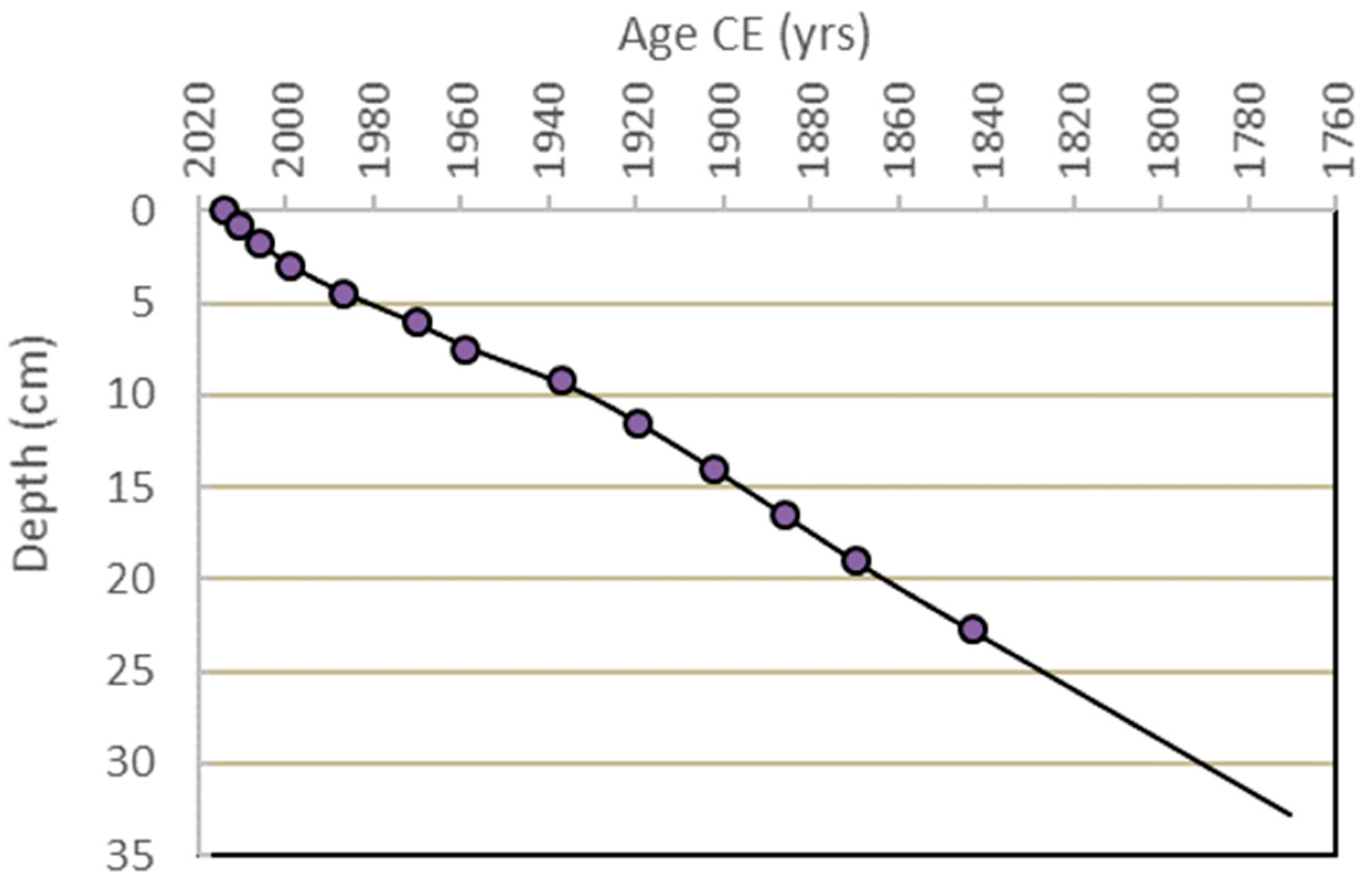

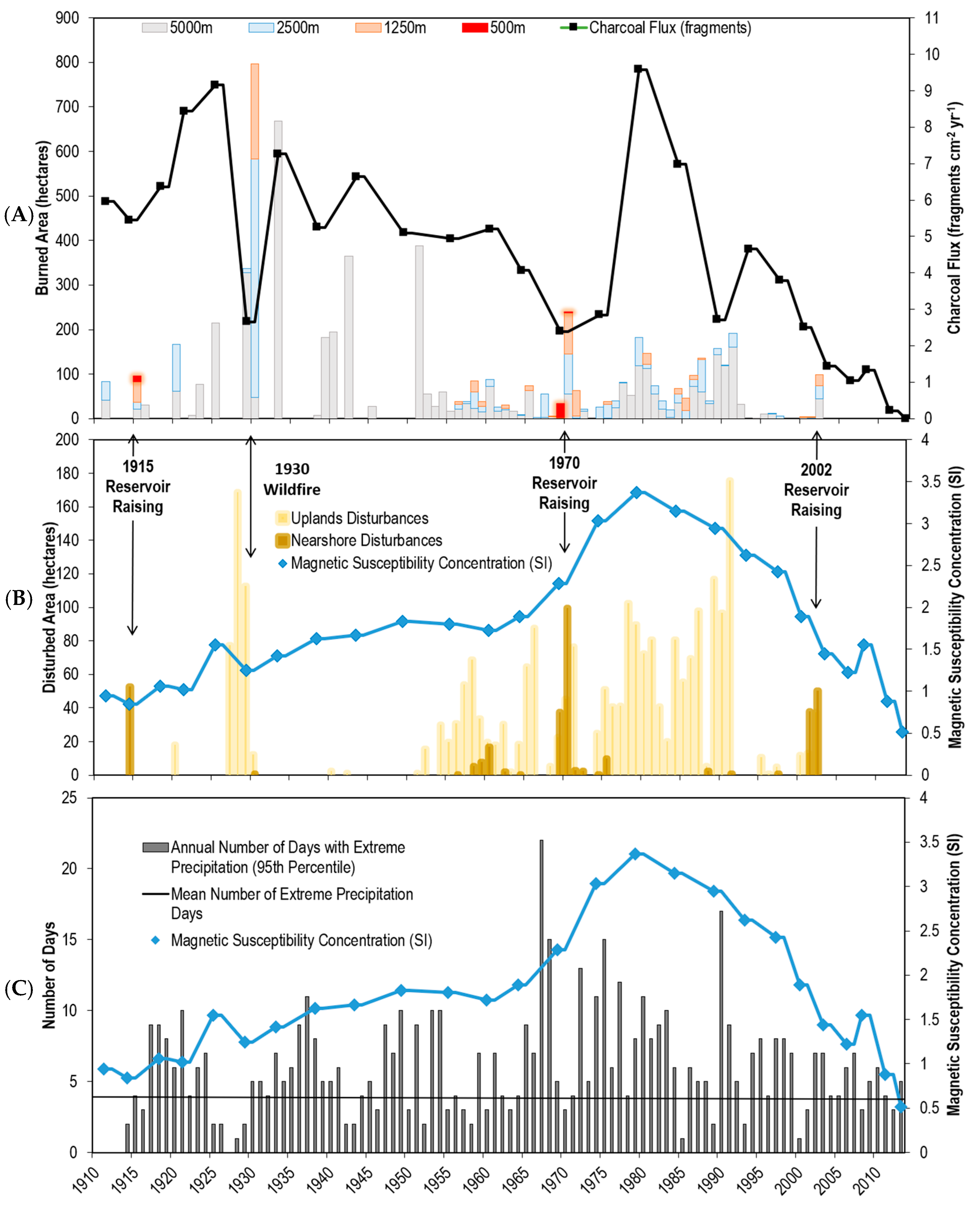
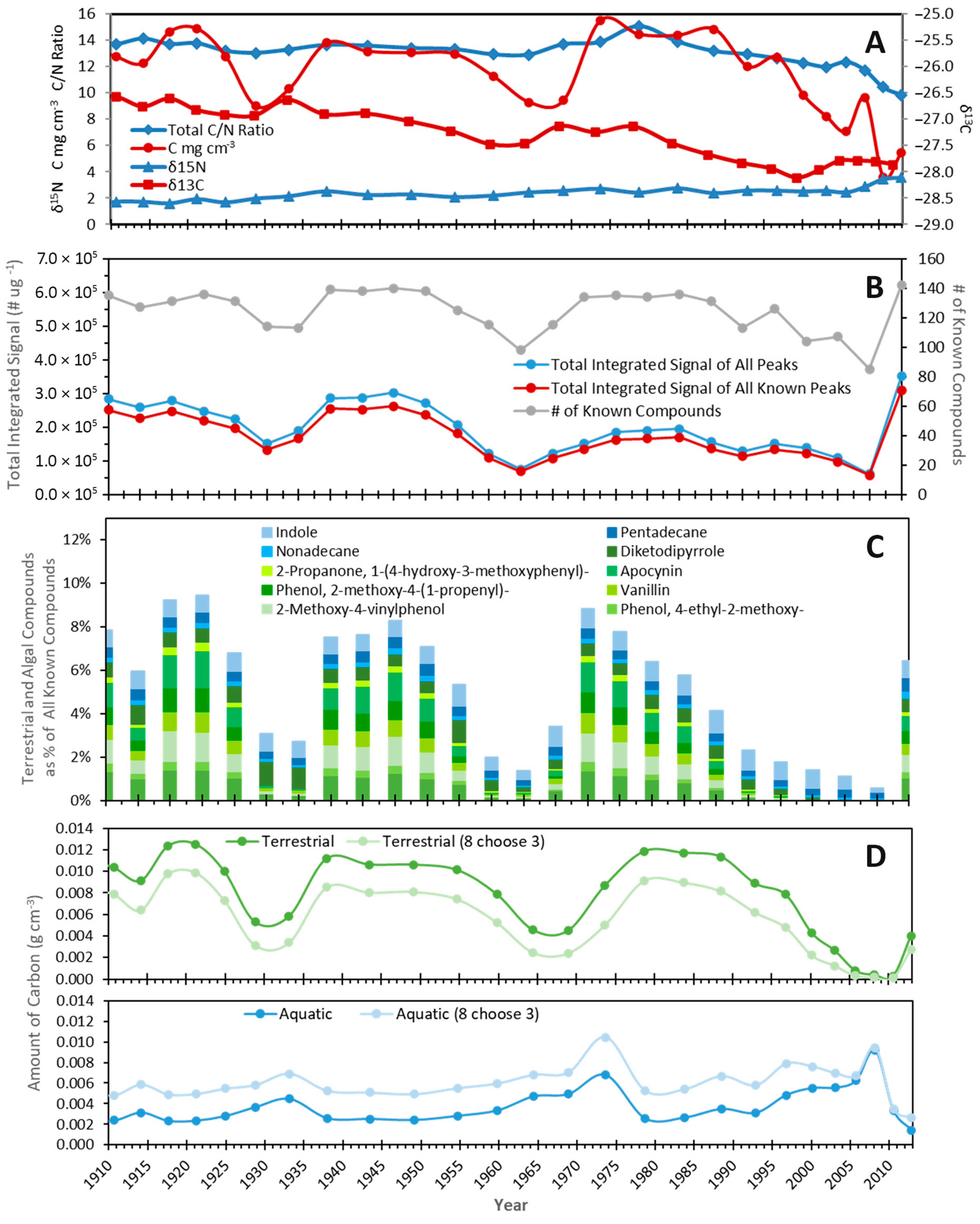
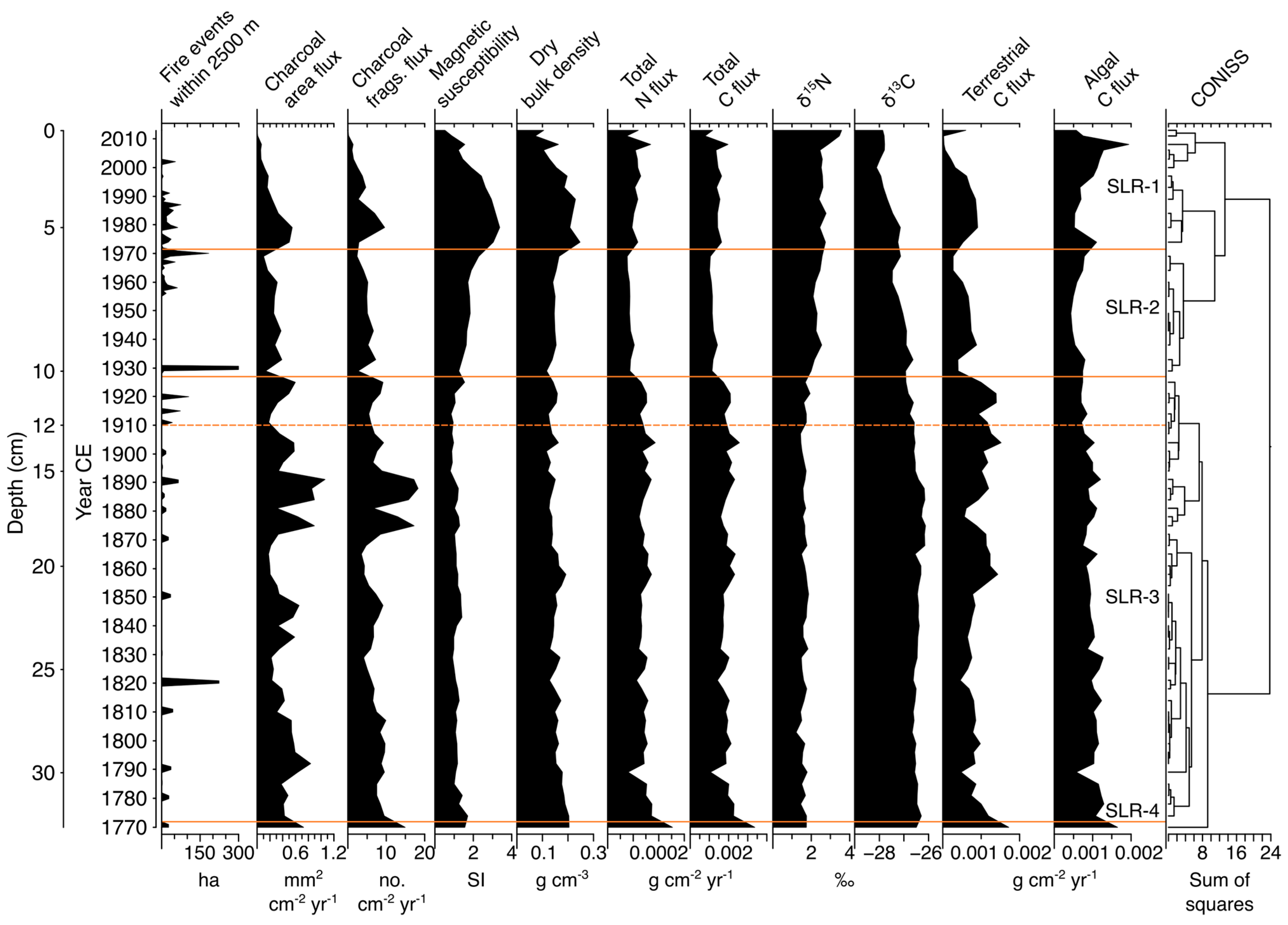
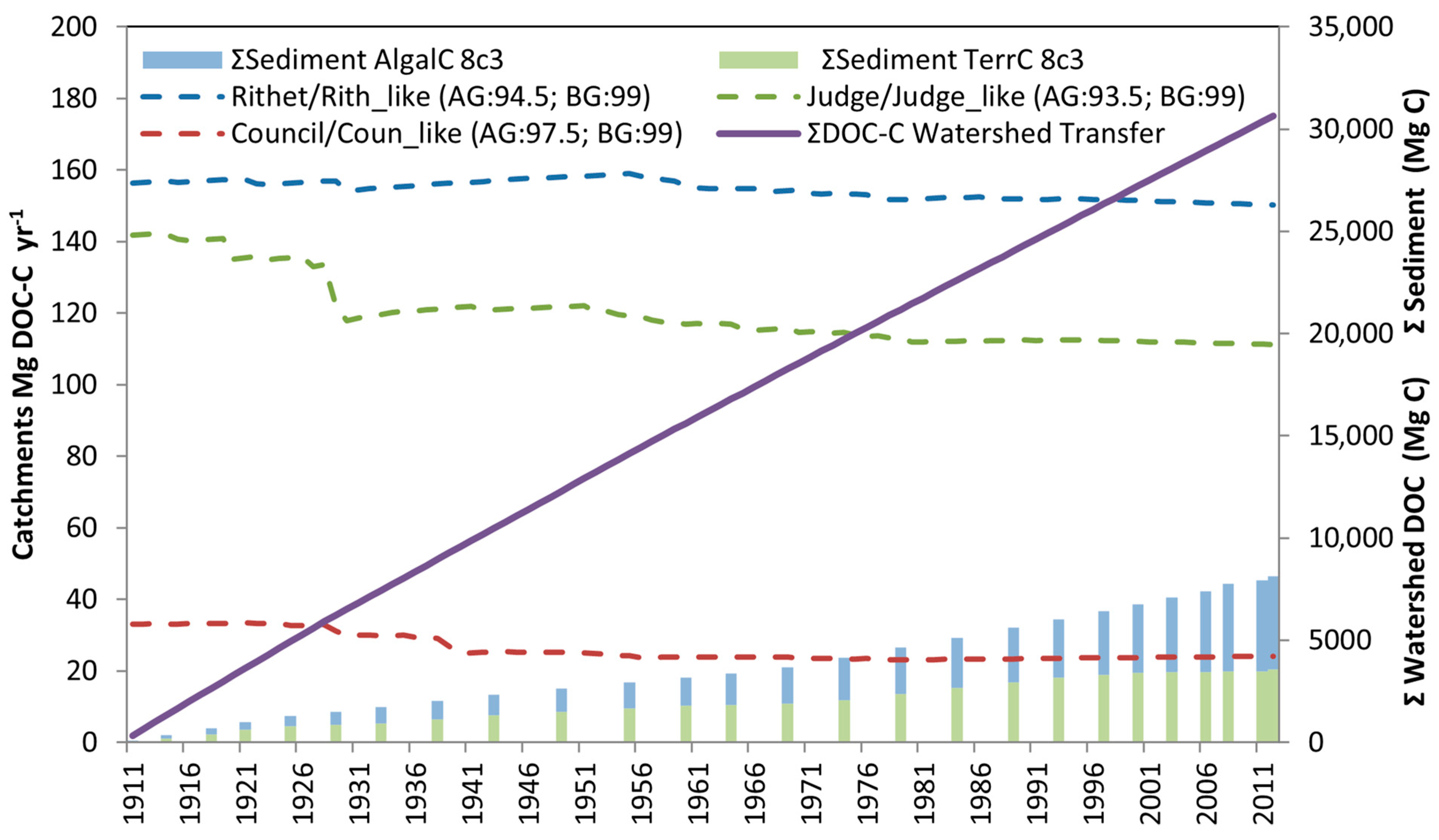
| Disturbance | Description | Agent |
|---|---|---|
| Wildfire | Human-caused fire | Fire |
| Wildfire | Wildfire | Fire |
| Wildfire | Pre-1910 stand establishment presumed after fire | Fire |
| Slashburn | Residual pile burn post-logging | Fire |
| Slashburn | Broadcast (slash) burn post-logging | Fire |
| Slashburn | Pile burn and ash trucked out | Fire |
| Partial Burn | Partial burn | Fire |
| Land Clearing | Clearcut logging for transmission line | Erosion |
| Land Clearing | Land-clearing logging | Erosion |
| Land Clearing | Land-clearing logging with biomass export | Erosion |
| Land Clearing | Land-clearing logging with pile burn | Fire and Erosion |
| Land Clearing | Land-clearing logging for road or rail right-of-way | Fire and Erosion |
| Land Clearing | Land-clearing logging with broadcast (slash) burn | Fire and Erosion |
| Location and Period | No. | Value | Description | Reference |
|---|---|---|---|---|
| (a) Terrestrial C % of Total C | ||||
| SLR 1911–2012 | 1 | 43 (Tm8c3) to 63 (Tm8) | Coastal Pacific reservoir | This study |
| SLR 1990–2012 | 1 | 27 (Tm8c3) to 43 (Tm8) | Coastal Pacific reservoir | This study |
| SLR 1770–1910 | 1 | 48 (Tm8c3) to 70 (Tm8) | Coastal Pacific lake 1 | This study |
| Sweden 2015 1 cm and 5 cm | 12 | 66 (range 46–80) | Boreal lowland, arctic lakes | [58] |
| Canada, Ontario 1971–2010 | 1 | 92 | Boreal headwater lake | [59] |
| Sweden, 2004–2005 | 12 | 50 to 70 | Boreal lake surface sediment | [60] |
| (b) Total OCAR gC m−2 yr−1 | ||||
| SLR 1911–2012 | 1 | 13.08 | Coastal Pacific reservoir | This study |
| SLR 1770–1910 | 1 | 18.9 | Coastal Pacific lake | This study |
| Canada, east Quebec | 11 | 5.29 (range 1.09–19.71) | Boreal lake surface sediments | [61] |
| Canada, east Quebec | 11 | 3.92 (range 1.15–8.02) | Boreal lake deeper sediments | [61] |
| Switzerland, 1921–2012 | 1 | 85 | Perialpine lake soil erosion | [62] |
| Switzerland, 1950–1970 | 1 | 150 | Perialpine lake eutrophication | [62] |
| Switzerland, ca. 834–1100 | 1 | 25 | Perialpine low impact | [62] |
| N. America, <1900 | 101 | 9.5 ± 0.5 | 101 northern lakes | [56] |
| N. America, 1900–1950 | 101 | 12.4 ± 0.8 | 101 northern lakes | [56] |
| N. America, 1950–2015 | 101 | 15.0 ± 0.8 | 101 northern lakes | [56] |
| Canada, Ontario 1890–2005 | 80 | 5 to 40 | Boreal remote or impacted lakes | [57] |
| (c) Terrestrial OCAR gC m−2 yr−1 | ||||
| SLR 1911–2012 | 1 | 5.77 (Tm8c3) to 8.34 (Tm8) | Coastal Pacific reservoir | This study |
| SLR 1770–1910 | 1 | 8.97 (Tm8c3) to 13.2 (Tm8) | Coastal Pacific lake | This study |
| Sweden, 2004–2005 | 12 | 55 ± 44 | Boreal lake surface sediment | [60] |
| (d) Watershed C transferred % sequestered in sediment | ||||
| SLR 1911–2012 | 1 | 11 (Tm8c3) to 17 (Tm8) | Coastal Pacific watershed | This study |
| Canada, Ontario 1971–2010 | 1 | 37 (wDOC) 2 | Boreal headwater | [59] |
| Canada, Ontario 12 yr < 1996 | 20 | 27 to 47 | Boreal catchments | [63] |
Disclaimer/Publisher’s Note: The statements, opinions and data contained in all publications are solely those of the individual author(s) and contributor(s) and not of MDPI and/or the editor(s). MDPI and/or the editor(s) disclaim responsibility for any injury to people or property resulting from any ideas, methods, instructions or products referred to in the content. |
© 2025 by the authors. Licensee MDPI, Basel, Switzerland. This article is an open access article distributed under the terms and conditions of the Creative Commons Attribution (CC BY) license (https://creativecommons.org/licenses/by/4.0/).
Share and Cite
Trofymow, J.A.; Brown, K.J.; Smiley, B.; Hebda, N.; Dixon, R.; Dunn, D. Multi-Centennial Disturbance History and Terrestrial Carbon Transfers in a Coastal Forest Watershed Before and During Reservoir Development. Forests 2025, 16, 1549. https://doi.org/10.3390/f16101549
Trofymow JA, Brown KJ, Smiley B, Hebda N, Dixon R, Dunn D. Multi-Centennial Disturbance History and Terrestrial Carbon Transfers in a Coastal Forest Watershed Before and During Reservoir Development. Forests. 2025; 16(10):1549. https://doi.org/10.3390/f16101549
Chicago/Turabian StyleTrofymow, John A., Kendrick J. Brown, Byron Smiley, Nicholas Hebda, Rebecca Dixon, and David Dunn. 2025. "Multi-Centennial Disturbance History and Terrestrial Carbon Transfers in a Coastal Forest Watershed Before and During Reservoir Development" Forests 16, no. 10: 1549. https://doi.org/10.3390/f16101549
APA StyleTrofymow, J. A., Brown, K. J., Smiley, B., Hebda, N., Dixon, R., & Dunn, D. (2025). Multi-Centennial Disturbance History and Terrestrial Carbon Transfers in a Coastal Forest Watershed Before and During Reservoir Development. Forests, 16(10), 1549. https://doi.org/10.3390/f16101549






